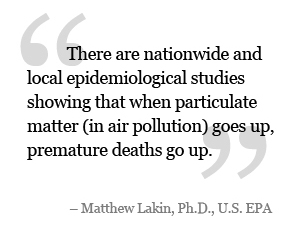Where There’s Smoke, There’s Climate Change: New Connections Between Climate Change and Wood Burning
Burning wood produces soot and methane, the second- and third-leading causes of global warming, respectively. Soot, also known as black carbon, kills approximately 1.5 million people per year worldwide, and methane increases ozone, which negatively impacts global health.
Not only are black carbon and methane themselves pollutants, but increasing levels of these combustion products lead to temperature increases that in turn worsen the health effects of air pollution. A recent study at Stanford University notes, “Controlling soot and methane may be the only methods of preventing loss of the Arctic sea ice and a tipping point to more rapid global warming.”
The impact of black carbon on climate change, especially as it impacts California, was the focus of the California Air Resources Board Meeting on May 24, 2012. Scientists from the EPA, Stanford University, UC Berkeley, UC San Diego, and the Pacific Northwest National Laboratory described how soot and brown carbon (a combination of soot, methane, and other fine organic particles) are affecting our climate at the regional and global levels in ways that undermine the very foundations of our climate systems.
The presenters noted that black and brown carbon are principally regional pollutants formed by incomplete combustion of fossil fuels, biofuels, and biomass such as wood. The resulting fine particles go directly into the atmosphere, remaining aloft for days or weeks. According to the EPA, “Controlling direct fine particle emissions from sources can be a highly effective air quality management strategy, with major public health benefits. Targeted reductions in black carbon emissions can provide significant near-term climate benefits.”
Reducing wood burning reduces the production of black and brown carbon as well as methane and may help slow climate change. In addition, reducing wood smoke will improve air quality, improve public health, and relieve some of the burden on the climatic systems that sustain life on earth.




